
Yakub Usmonovich Usmonov
All sciences. №7, 2022. International Scientific Journal
PHYSICAL SCIENCES
THE USE OF NEW NANOSTRUCTURE METHODS ALLOWING TO INCREASE THE MONOCHROMATICITY OF THE BEAM DURING ACCELERATION
UDC 621
Rinat Fuadovich Rumi
Senior Researcher, Head of the Laboratory of Accelerator Technology at the Research Institute “Physics of Semiconductors and Microelectronics” at the National University of Uzbekistan
Laboratory of Accelerator Technology at the Research Institute “Physics of Semiconductors and Microelectronics” at the National University of Uzbekistan, Tashkent, Uzbekistan
Abstact. The development of accelerator technology has been actively observed after numerous works by Ernest Rutherford, from the discovery of the planetary model and the implementation of the first nuclear reaction to the present day. And it is worth noting that for each time there were quite interesting requirements for charged particle beams, among which the most popular requirement at almost all times was the beam energy, then its current can be noted, but one of the most important among them is the monochromaticity of the charged particle beam.
Keywords: monochromaticity, monoenergetics, charged particle beam, accelerator, nanostructures.
Аннотация. Развитие ускорительной техники наблюдалось активно после многочисленных работ Эрнеста Резерфорда, от открытия планетарной модели и осуществления первой ядерной реакции до сегодняшний дней. И стоит отметить, что для каждого времени существовали довольно интересные требования к пучкам заряженных частиц, среди коих самым популярным требованием почти во все времена являлась энергия пучка, затем можно отметить его ток, но одним из важных среди них является монохромотичность пучка заряженных частиц.
Ключевые слова: монохроматичность, моноэнергетичность, пучок заряженных частиц, ускоритель, наноструктуры.
Introduction
Initially, it is necessary to give a general concept of the monochromaticity parameter itself, which is often associated with monoenergetics. The whole point is that the beam, after its formation by thermionic, auto- or other emission, has a heterogeneity in energy, which is why the particles in its various regions have different, albeit slightly distinguishable energies. With acceleration, their given spread or gradient increases, although it becomes smoother. For example, on accelerators of the 80s, an example of which is the SOKOL-2 accelerator, monoenergetics of up to 5 keV is achieved at 2 MeV of the total beam energy, while on modern accelerators, at an energy of 20 MeV, an accuracy of up to 1 keV is achieved in maximum accuracy.
Problems
If the question arises about the figure of this value, then it is thanks to it that we can talk about the effectiveness of the entire reaction, because as far as the energies in the beam are homogeneous and have a value close to each other, so much more of them will be close to the energy desired for this reaction channel – to the necessary resonance, which will make the reaction more efficient.
Today, exo-energetic nuclear reactions are known, the output particles in which have more energy than at the input, but at the same time such a reaction takes place only for a part of the particles due to the very smallness of the total monoenergetics of the beam.
Solving the problem
To achieve results, that is, to increase the efficiency of the conducted nuclear reaction, it is necessary to increase monoenergetics, and for this it is necessary to develop a method for equalizing energy on different parts of the beam. As is known, in a magnetic field, under the influence of the Lorentz force (1—2), particles are deflected, while the beam at the maximum energy in its center and decreasing closer to the edges is stratified, passing into a kind of energy gradient.


Further, it is more likely that the beam will be divided into component parts, where the losses will be much less than it would be with “beam selection” with losses of more than 90%, namely, for divisions, the losses will be only 12%. Nanotubes, in themselves, are formations resembling carbon tubes that transmit a charge, but at the same time separated from each other by a dielectric layer of molecules.
For the formation of a charge in such a system, a vertical and horizontal transmission line is carried out to each tube, with the closure of which this particular cell is charged. When a second system of the same type is located opposite, a potential difference arises between them, thanks to which it is possible to give energy in the gradient spectrum, the reverse of the incoming beam gradient, while losing only 12% of the total number of charges, and, accordingly, current.
At the same time, it is important to note that although it is not so difficult to vary the potential differences within the framework of a modern 1 keV accelerator, but the accuracy is not infinite. While maintaining the same voltage ratio for 20 MeV, an accuracy of up to 0.04—0.05 eV can be achieved, which is a shocking result.
But this technology is currently being developed in a theoretical matter and is not without disadvantages, for example, such a system is suitable for fairly small beams with currents of 1 nA and only in very rare cases up to 1 µA, but it is possible to find a solution with the creation of sets of such small beams divisible in the future, but this stage is the beginning a new study that further increases the efficiency of accelerator technology and possibly, with the implementation of this technology on the charged particle accelerator of the Electron project, it will become possible to name this accelerator having the highest monoenergetics of the beam, and, accordingly, the highest efficiency of all nuclear reactions carried out on it.
Used literature
1. Karimov B. H. Elektronika asoslari. Study guide. – [B.M.]: Scientific school “Electron”, Publishing solutions. Ridero, 2022. – 176 p
.2. Aliyev I. H., Karimov B. H. Course of physics of charged particle accelerators. Study guide. – [B.M.]: Scientific school “Electron”, Publishing solutions. Ridero, 2022. – 203 p.
3. Aliyev I. H., Karimov B. H., Karimov Sh. B., Yuldoshaliev D. K. Industrial and alternative aerators based on green energy for fish reservoirs. Monograph. – [B.M.]: Scientific school “Electron”, Publishing solutions. Ridero, 2022. – 221 p.
4. Aliyev I. H., Burnashev M.A. Ingential mathematics. Monograph. – [B.M.]: Scientific school “Electron”, Publishing solutions. Ridero, 2022. – 149 p.
5. Aliyev I. H., Karimov B. H., Karimov Sh. B., Yuldoshaliev D. K. Development of aerator technology based on alternative energy sources. The Electron project. Monograph. – [B.M.]: Scientific school “Electron”, Publishing solutions. Ridero, 2022. – 141 p.
6. Aliyev I. H. Software modeling of nuclear reaction phenomena based on the technology of creating a set of data using a system of algorithms in C++. The Core-COMPUTER project. Monograph. – [B.M.]: Scientific school “Electron”, Publishing solutions. Ridero, 2022. – 156 p.
7. Karimov B. H., Mirzamakhmudov T. M. Electronics asoslari. Study guide. – [B.M.]: Scientific school “Electron”, Publishing solutions. Ridero, 2022. – 184 p.
8. Aliev I. H. New parameters for nuclear reactions to be carried out on an accelerator of charged particles of the LCU-EPD-300 type. The Electron project. Monograph. – [B.M.]: Scientific school “Electron”, Publishing solutions. Ridero, 2022. – 498 p
.9. Aliyev I. H. Software modeling of nuclear reaction phenomena based on technologies for creating a set of data using a system of algorithms in C++. The Core-COMPUTER project. Monograph. – [B.M.]: Scientific school “Electron”, Publishing solutions. Ridero, 2022. – 498 p.
10. Aliev I. H., Sharofutdinov F. M. The use of accelerators and the phenomena of collisions of elementary particles with high-order energy to generate electrical energy. The Electron project. Monograph. – [B.M.]: Scientific school “Electron”, Publishing solutions. Ridero, 2021. – 594 p.
11. Otazhonov S. M., Alimov N. E. Photoelectric phenomena in wide-band semiconductor heterostructures with deep impurity levels. Monograph. – [B.M.]: Scientific school “Electron”, Publishing solutions. Ridero, 2022. – 112 p.
12. Otazhonov S. M. “Mavzu ishlanmasi” tayyorlashning innovatsion xarakterga ega bo’lgan metodi. Monograph. – [B.M.]: Scientific school “Electron”, Publishing solutions. Ridero, 2022. – 158 p.
13. Karimov Sh. B., Karimov B. H., Aliyev I. H. Spatially oscillating photovoltaic current in an optically active SbSl ferroelectric. All sciences. – №6. Electron Scientific School, Publishing solutions. Ridero, 2022. – pp. 33—50.
14. Zhalolov B. R., Karimov B. H., Aliyev I. H. The role of resonant nuclear reactions in modern energy. The role of resonant nuclear reactions in modern energy. All sciences. – №6. Electron Scientific School, Publishing solutions. Ridero, 2022. – pp. 50—113 p.
15. Aliyev I. H. Prospects for the use of neutron energy. All sciences. – №6. Electron Scientific School, Publishing solutions. Ridero, 2022. – pp. 122—133.
16. Zhalolov B. R. Investigation of solar physics in the study of the solar energy industry. All sciences. – №5. Electron Scientific School, Publishing solutions. Ridero, 2022. – pp. 11—29.
17. Aliyev I. H. On a heuristic idea about the emergence of a new energy technology for obtaining energy from resonant nuclear reactions. All sciences. – №1. Electron Scientific School, Publishing solutions. Ridero, 2022. – pp. 13—18.
18. Karimov B. H. A general idea of the LCC-EPD-20 accelerator. All sciences. – №1. Electron Scientific School, Publishing solutions. Ridero, 2022. – pp. 18—23.
19. Zhalolov B. R. Implementation and scientific publications on the Electron project. All sciences. – №1. Electron Scientific School, Publishing solutions. Ridero, 2022. – pp. 23—28.
20. Sharofutdinov F. M. Statement of facts about the stages of development of the Electron project and the brightest hopes for the future. All sciences. – №1. Electron Scientific School, Publishing solutions. Ridero, 2022. – pp. 28—33.
21. Aliev I. H. Aluminum resonance reaction. All sciences. – №3. Electron Scientific School, Publishing solutions. Ridero, 2022. – pp. 24—44.
22. Sharofutdinov F. M. On the introduction of a new nuclear energy unit from the point of view of economics and diplomacy. All sciences. – №6. Electron Scientific School, Publishing solutions. Ridero, 2022. – pp. 347—361.
23. Aliyev I. H., Umarova G. M. The use of innovative technologies in teaching. Humanitarian treatise – No. 78. Publishing house “Pluto”. 2020 – pp. 17—18.
24. Aliyev I. H., Karimova M. I. The role of the philosophical meaning of the work in teaching in schools. Humanitarian treatise – No. 79. Publishing house “Pluto”. 2020 – pp. 36—38.
25. Aliyev I. H., Nishonova D. O. Nikola Tesla Tower. A humanitarian treatise. – №92. Publishing house “Pluto”. 2020. – pp. 9—13.
26. Aliyev I. H., Karimova M. I., Kharipova S. B. A new step method. A humanitarian treatise. – №92. Publishing house “Pluto”. 2020. – pp. 14—17.
27. Aliyev I. H., Karimov B. H. On a heuristic idea regarding the algorithmization of the functioning of the human brain based on the theories of electromagnetic fields of biological streams and their active interaction with other objects and dimensions. Oliy va o’rta maxsus ta’lim vazirligi huzuridagi “Oliy ta’limni rivojlantirish tadqiqotlari va ilg’or texnologiyalarini tatbiq etish markazi” “Ilm, ma’rifat va raqamli iqtisodiyotni rivojlantirish istiqbollari” Onlayn Respublika ilmiy-amaliy anjuman maruzalar to’plami. Tashkent. 2020. – pp. 164—178.
28. Aliev I. H. Collision energy of oncoming beams. A young scientist. International Scientific Journal. – №16 (306). Publishing house “Young Scientist”. 2020. – pp. 7—10.
29. Aliyev I. H., Karimov B. H., Karimov Sh. B., Yuldoshaliev D. K., Aliyev M. I. Alternative wind aerator for fish reservoirs. A young scientist. International Scientific Journal. – №49 (287). Publishing house “Young Scientist”. 2019. – pp. 173—175.
30. Aliyev I. H., Toshtemirov M. H., Karimov B. H. A device for using solar energy to increase temperature with a hydrodynamic mechanism in a common design, which is a solar collector. A young scientist. International Scientific Journal. – №18 (360). Publishing house “Young Scientist”. 2021. – pp. 117—120.
31. Aliyev I. H., Karimov B. H. Linear electron accelerator in power engineering. Exact science. – №85. Publishing house “Pluto”. 2020. – pp. 23—29.
32. Aliyev I. H. The behavior of an electron in an atom. Exact science. – №63. Publishing house “Pluto”. 2019. – pp. 37—39.
33. Aliyev I. H. Electron and its features. Exact science. – №71. Publishing house “Pluto”. 2020. – pp. 2—5.
34. Aliyev I. H. Entangled micro-friends. “Uyda qoling!” shiori ostida “Oliy ta’lim islohorlari: yuruqlar, muammolar, yechimlar” mavzusidagi respublika miqyusida onlayn ilmiy maqolalar hamda innovatsion ixtirolar tanlovining ilmiy maqolalar to’plami. Tashkent. 2020. – pp. 164—178.
35. Aliyev I. H., Karimov B. H., Mirzazhonov Z., Karimov N. I. Autonomous aerator for fish reservoirs. Ministry of Higher and Secondary Special Education of the Republic of Uzbekistan. Academy of Sciences of the Republic of Uzbekistan. Ministry of Innovative Development of the Republic of Uzbekistan. Fergana Polytechnic Institute. Proceedings of the V International and Conference on Optical and Photoelectric Phenomena in Semiconductor Micro- and Nanostructures. Part II. Ferghana. 2020. – pp. 147—149.
MATHEMATICAL SCIENCES
DIRECT APPLICATION OF IMPLICATION AND EQUIVALENCE
UDC 519.9
Nematov Islom
Candidate of Physical and Mathematical Sciences, Associate Professor of the Department of “Mathematics” of the Faculty of Mathematics and Computer Science of Fergana State University
Aliev Ibratjon Xatamovich
2nd year student of the Faculty of Mathematics and Computer Science of Fergana State University
Ferghana State University, Uzbekistan
Annotation. Discrete mathematics, which is increasingly gaining popularity, has also been able to find its own application thanks to the introduction of new information sciences using the binary number system, both in the face of classical and quantum computer science. In this paper, the question of finding not only the indirect, but also the direct direct application of implication and equivalence operations known since the 60s of the XX century, the search for which has continued to the present time, is considered.
Keywords: discrete mathematics, implication, equivalence, direct application, practical application, technical understanding, electrical circuit.
Аннотация. Дискретная математика всё больше получающая популярность также смогла найти и собственное применение благодаря введению новых информационных наук с использованием двоичной системы счисления, как в лице классической, так и квантовой информатики. В данной работе рассмотрен вопрос относительно нахождения не только известного ещё с 60-х годов XX века косвенного, но и непосредственного прямого применения операций импликации и эквиваленции, поиск коих продолжался до настоящего времени.
Ключевые слова: дискретная математика, импликация, эквиваленция, прямое применение, практическое применение, техническое осмысление, электрическая схема.
At the moment, a variety of operations are actively used in discrete mathematics and logic to describe the conduct of actions on judgments. So the main operations are conjunction, disjunction and negation, so known as logical multiplication, logical addition and logical negation, respectively. They allowed us to operate on various judgments that accept the result either “true” – 1 or “false” – 0.
Each of the operations at the same time had its own truth table. For conjunction it is (Table 1), for disjunction – (Table 2) and logical negation – (Table 3).
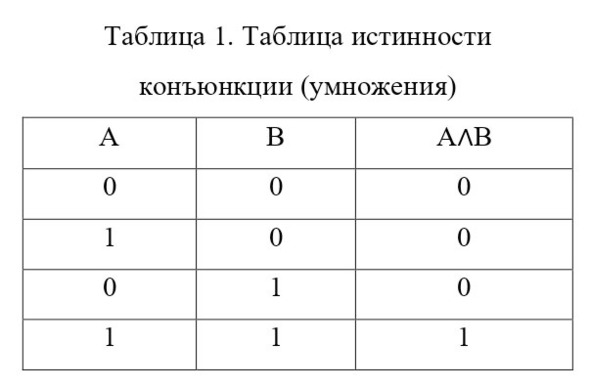

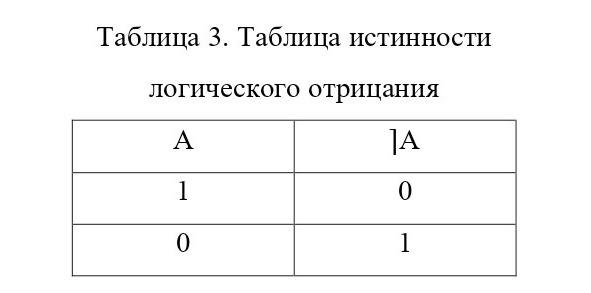
At the same time, for the conjunction (logical “And”), a serial connection scheme takes place in the practical description (Fig. 1), described in the following cases:
1. If there is no current through “A” and through “B”, as a result there is no current;
2. If there is a current in “A”, but in the absence through “B”, as a result there is no current;
3. If there is no current in “A”, but in the presence of “B”, as a result there is no current;
4. If there is a current in “A” and in the presence of “B”, as a result, there is a current.
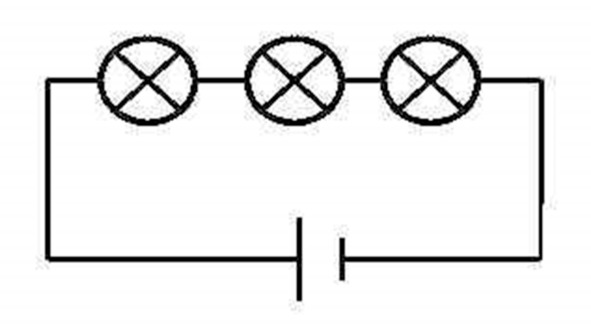
Fig. 1. Serial connection
For a disjunction (logical “OR”), a similar representation can be seen in the face of a parallel connection (Fig. 2), described already in the following cases:
1. If there is no current through “A” and through “B”, as a result there is no current;
2. If there is a current in “A”, but in the absence of through “B”, as a result, there is a current;
3. If there is no current in “A”, but in the presence of “B”, as a result, there is a current;
4. If there is a current in “A” and in the presence of “B”, as a result, there is a current.
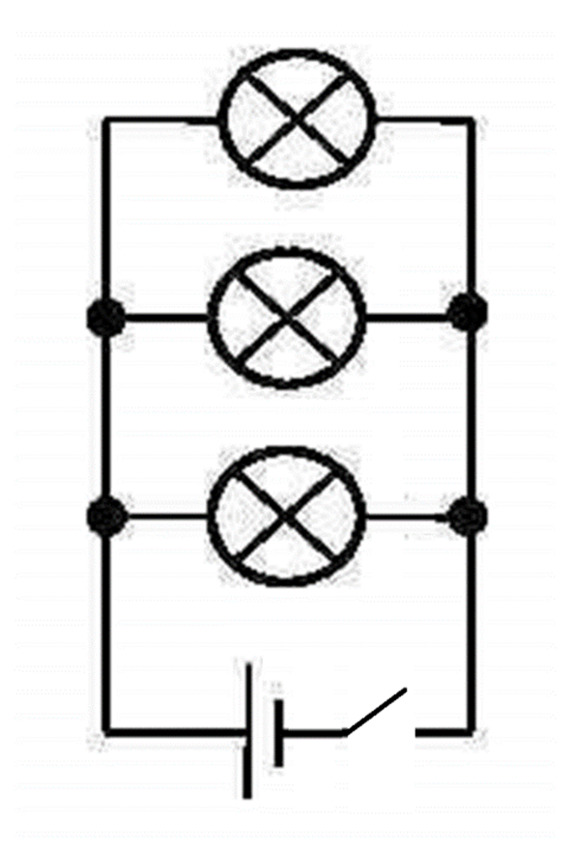
Fig. 2. Parallel connection
For logical negation (logical “NOT”), everything is even simpler, because it can be represented as an ordinary reverse button (Fig. 3), describing the actions as follows:
1. If there is a current in “A”, as a result there is no current;
2. If there is no current in “A”, as a result, there is a current.
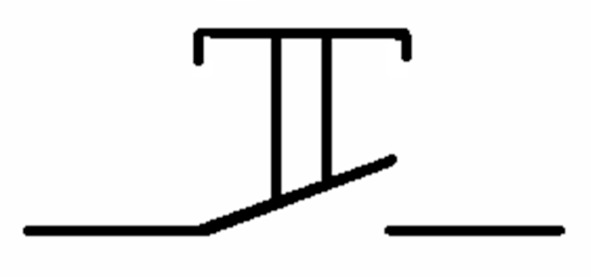
Fig. 3. “Button” – logical negation in the circuit
But along with these operations, there were also implication and equivalence operations, where implication is a logical consequence or statement “Follows from here”, and equivalence is logical equivalence and or the statement “Then and only then” had the following truth table (Table 4), and equivalence – (Table 5).
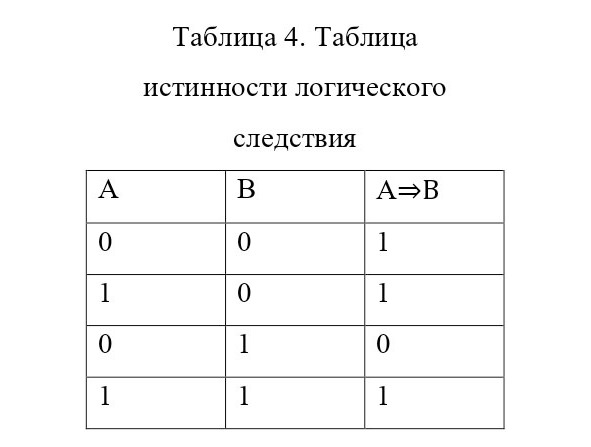
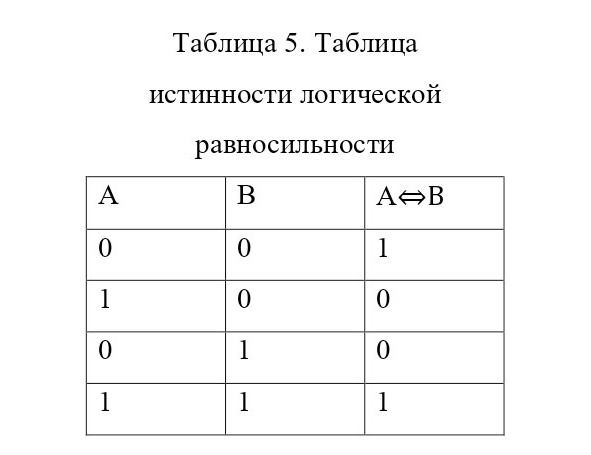
At the same time, both operations have not yet been applied in practice in direct form, as it looked for conjunction and disjunction. To date, the transformation is used for implication (1) and for equivalence (2).
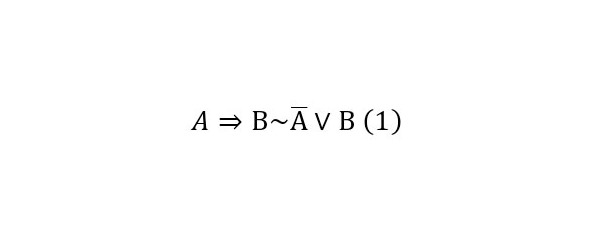
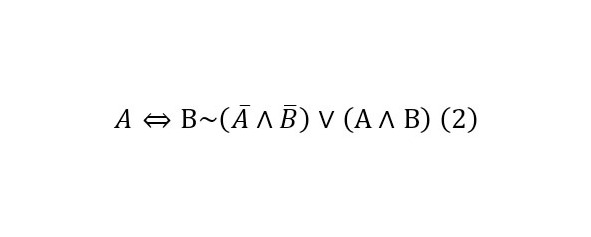
That is, the implication can be represented as a negation of the first and a disjunction with the second statement, and the equivalence as a conjunction of the negations of both judgments on the disjunction of the conjunction of both judgments. If we check the truth of (1) and (2) on the table, then the result will be valid (Table 6—7).
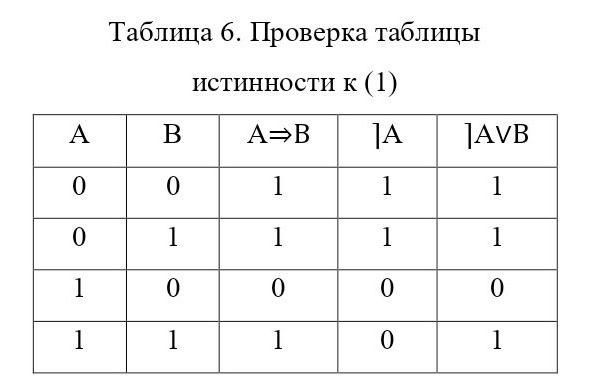
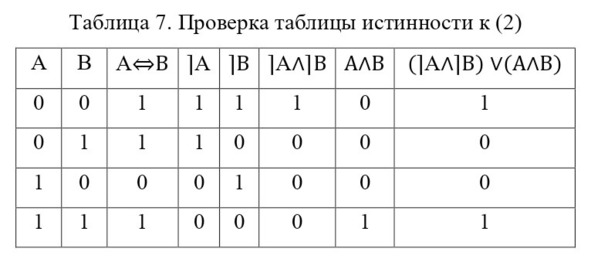
And the methods presented were considered the only possible ones to this day, until finally an electric element was created, a kind of connection in which implication and equivalence would be performed in the direct case.
The first device, the implicator, consists of a vacuum flask 7 with a cathode 3 and an anode 1, between which an anode grid 2 is placed. The distance between the cathode and the anode l is verified with the accuracy that it is less than or equal to the free path of electrons that have flown from the cathode to the anode. There is also an isolated electrode 6, connected from the outside (behind the bulb) to the cathode pin 3, but not connected to it (Fig. 4).
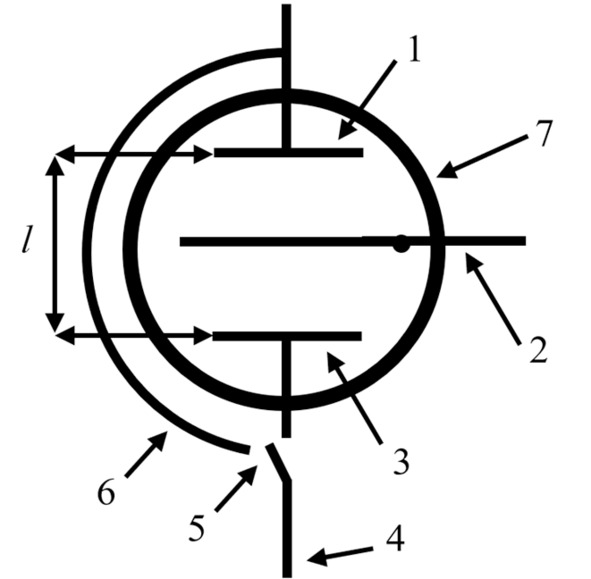
Fig. 4. Implicature scheme
Thus, let the anode grid 2 act as the second statement, the cathode 3 as the first, and the anode 1 as the result. At the same time, a condition is introduced that before the current 4 arrives at the cathode 3, a divider 5 is supplied, which reacts to the magnitude of the incoming current, if the current is greater than or equal to a certain value taken as the truth of the first judgment, then it is connected to the cathode 3, otherwise to the electrode 6 coming out of the anode. In this case, the exception is the case when there is a current on the anode grid 2, while it is assumed that the current does not go to the cathode and to the cathode circuit at all.
So, in this scheme, we can consider four situations:
1. If there is no current at the cathode and there is no current on the anode grid, then the current flows through the electrode to the anode, as a result there is a current;
2. If there is current at the cathode, but there is no current on the anode grid, then the electrons reach the anode, as a result there is current;
3. If there is no current at the cathode, but there is no current on the anode grid, there are also no electrons in the bulb, which is why there is no current as a result;
4. If there is current at the cathode and there is current on the anode grid, then the electrons receive additional acceleration, which means that there is also current as a result.
This device, as you can see, although with a couple of conventions, which can be completely replaced by reducing elements, a kind of sensors or switches, fully performs the function of implication. But it is also interesting to mention here that neither conjunction nor disjunction was used, nor even negation, unless of course the “switch” is considered an extremely distant relative of negation, which would be inappropriate. Moreover, this system acts as a single element that fully fulfills the task.
Speaking of this type of connection, it should be called a “close mixed” connection, or a “Promichtovoe” connection, from the Latin prore – “close” and mixta – “mixed”, since both parallel and serial connection are involved here, but more figuratively, because of which this connection acts new – the third kind.
The situation with equivalence is similar, but the difference is that the distance between the cathode 3 and the anode 1 – L (for the equivalentor) must be strictly greater than the electron path length so that they cannot reach it without the help of an anode grid, which, however, explains why the implicator is connected “close-mixed” connection. When using the same equivalentor (Fig. 5) – a device that performs the function of equivalence, there are also 4 cases:
1. If there is no current at the cathode and there is no current on the anode grid, then the current flows through the electrode to the anode, as a result there is a current;
2. If there is current at the cathode, but there is no current on the anode grid, then the electrons do not reach the anode, as a result there is no current;
3. If there is no current at the cathode, but there is no current on the anode grid, there are also no electrons in the bulb, which is why there is no current as a result;
4. If there is a current at the cathode and there is a current on the anode grid, then the electrons receive additional acceleration, which means that there is a current as a result.

Fig. 5. The scheme is equivalent to
The equivalentor is similarly connected by the type of connection in this case by a “far-mixed” or “Longmichth” connection, from the Latin longe – “far away” and mixta – “mixed”.
Thus, it is possible to demonstrate two elements – an implicator and an equivalentor that fully perform the functions of implication and equivalence in modern electronics, finding perfect application, allowing to reduce space at times, because these circuits can be made in an arbitrarily small size, along with replacing the “diode-lamp” part with the presence of vacuum with modern triodes with the usual additional switchable connection for the implicator and more upgraded triodes with the same switches and connection for the equivalentator.
Presenting this scheme, we can hope that it will bring its benefits, contributing to the development of modern science and technology, improving and bringing new things to science, as well as opening up new even more grandiose horizons to the entire human civilization!





